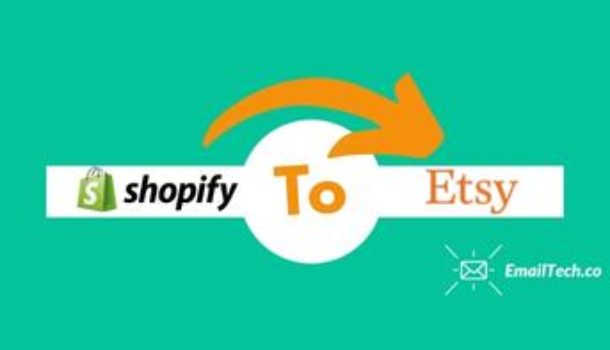If you want to extend your product reach from Shopify to the Etsy marketplace, there shouldn’t be a reason to build a new Etsy store if you already have an existing on Shopify one. Instead, you simply want to learn how to migrate your store from Shopify to Etsy. This piece shares an in-depth method to move your store from Shopify to Etsy.
How To Migrate From Shopify To Etsy
There are several ways you can migrate your products from Shopify to Etsy. These methods have varying results, however. Therefore, instead of randomly choosing a migration method, you want to confirm what features you will enjoy. Below are some of the common ones;
Native Integration – Etsy Marketplace Integration
The simplest way you can migrate products from Shopify to Etsy is through Shopify’s native integration with Etsy. The Etsy Marketplace integration offers a well-rounded list of functions – giving you features you will enjoy from both Shopify to Etsy. This full migration integration allows you to easily manage listings, inventory, and orders, amongst the key functions.
The native integration offers a free plan and a free 7-day trial for paid plans based on your business needs. Generally, the integration allows you to carry out advanced attribute management on the product listing, enjoy real-time syncing with inventory and pricing, and even enjoy advanced order management – opting for customizations such as order tracking.
However, some of the processes will be similar. For example, whether you opt for the free plan or paid plan, you will still incur Etsy’s $0.20 charge per listing, although, this also means that you will enjoy perks such as free around-the-clock customer support. As mentioned above, the integration is available in free and paid plans.
The free plan allows you to upload up to 10 products on Etsy, manage 10 orders at a time, and pay no commission on orders. The paid plans include the Starter, Lite, and Basic – costing $39 (or $24.92 if paid annually), $59 (or $33.25 if paid annually), and $69 (or $41.58 if paid annually) per month, respectively.
The starter extends to 100 product management, digital product support, multi-currency, and shipping management. The Lite plan extends to 10000 products and up to 400 orders with Product/order error information and stock control. The Basic plan on the other end covers up to 5000 products and 1000 orders per month along with additional features such as tracking details customization and order tagging.
Steps
- To connect the two apps, log in to your Shopify account and head to the Shopify app store.
- Pick the Etsy option and add the app.
- You will then be redirected to the Etsy page.
- Set up your Etsy account and log in.
- Follow the instructions for syncing the two apps and the stores will be linked – allowing you to use them.
Native Integration – Etsy Inventory Management Sync and Sell
Alternatively, you can migrate Shopify to Etsy through the inventory management integration. In this case, you will pick the Etsy Sync and Sell integration. Whilst the app is available on the Shopify app, it is designed by ShopFunnel.io.
This integration allows you to sync products, inventory, and orders – making your work less cumbersome. Similar to the marketplace integration, this one offers a free and paid plan. For the paid plans, you also have the option of a 5-day free trial. The free plan gets you started on the basics.
The paid plan is available in the Standard option which costs $29.99 per month and offers key inventory features along with up to 500 orders or product imports per month and standard support. The Pro plan on the other end covers all key inventory features, offers premium support, and covers unlimited order and product imports. The pro plan costs $34.99 per month.
Steps
- To connect the sync and sell app with Shopify, log in to your Shopify account and head to the Shopify app store.
- Pick the Etsy: Sync and Sell option and add the app.
- You will then be redirected to the Etsy page.
- Set up your Etsy account and log in.
- Follow the instructions for syncing the two apps and the stores will be linked – allowing you to use them.
Third Party Migration
You can also opt to migrate Shopify to Etsy through third party apps. Some of the key ones are listed below;
LitExtension
The LitExtension platform is powered to facilitate a Shopify to Etsy migration. This migration process allows you to transfer important data such as products, customers, orders, blogs, and other related data. Migrated product details include the names, descriptions, keywords, and even Meta descriptions/titles/keywords. The LitExtension process is secure, accurate, and automatic.
Plus, it supports Shopify and Shopify Plus plans. This is a paid service – depending on the migration size. For example, for 10 products, customers, and orders, you will pay $119 with a single-day fulfillment time. If you transfer 10,000 products, customers, orders, you will pay $599 with a 3 day fulfillment time. You can easily calculate the migration pricing on the LitExtension site based on the number of products, customers, and orders you wish to migrate.
Steps
- Set up a LitExtension account and head over to the cart migration menu
- Select Shopify as a Source Cart from the drop-down list and enter your Shopify store’s URL
- Follow the brief instructions to set up the Connector
- Select Etsy as Target Cart from the dropdown list and enter your Etsy store’s URL
- Follow the brief instructions to get your API information
- Choose the entities/data you want to migrate from Shopify to Etsy
- Then, activate the migration process. When the process kicks off, it will continuously run even when you turn your browser off.
ExportFeed
ExportFeed is another third party app option to integrate your Shopify store with Etsy. The app offers a Shopify Etsy integration which ensures product, orders, and inventories on both platforms are always synced. You can even add other details such as product attributes and mapping. This method, however, is paid for and doesn’t offer a free plan. Instead, it offers a 5-day free trial and after that, you will pay $29.99 per month.
Steps
- Log into your Shopify account and head to the Shopify store
- Choose the Etsy & ShareASale integration
- Follow the steps for connecting the app and then, add products you want to integrate into Etsy under different collections to prevent from mixing them up with those you want to sell on Shopify only or those you want to sell on both platforms
- Log into your Etsy account and connect the Etsy store with Shopify and select the products you want to add to Etsy
Typically third party migration of your Shopify store to Etsy is done through coding APIs. This method involves connecting the two platforms at the base level. Shopify and Etsy provide authorized developers with their API keys and allow them to develop solutions and apps.
This is why you will find many different third party apps selling solutions that allow you to connect the two apps in a wide range of features. Larger and enterprise-level businesses with bigger budgets can even hire third party agencies/Shopify Experts who have access to the API keys just like authorized developers. These agencies then develop a full migration.
Why Shopify To Etsy?
There are many reasons why you may want to migrate your online store from Shopify to Etsy – it may simply be that you want to seek after certain features that the other platform doesn’t offer, or simply because you want to expand customer reach and increase revenue. On the other hand, it may simply be that you want to sell your products on Etsy without having to close down or stop using your Shopify store.
Both Shopify and Etsy are ecommerce software options that allow you to build and manage your online store. However, they also come with their own differences.
Shopify is an ecommerce platform that allows you to build your own hosted and dedicated site and gives you the freedom to customize and design it how you want so you can stand out to your audiences. The platform offers a range of tools including design themes and integrations with other apps such as analytics, payment gateways, shipping, and even email marketing apps. Etsy, on the other hand, works slightly differently.
Instead of being a dedicated site, Etsy functions as a marketplace similar to platforms such as Amazon or eBay. So, instead of having your own storefront, using Etsy means that you will join a host of other vendors on a single online site or platform.
So, whilst Shopify allows you to have a dedicated, standalone online store in the form of a website, Etsy allows you to sell from the same platform as other vendors and works best for a seller that wants to quickly put up their products and being selling – eliminating the need to build and manage complex processes.

